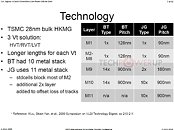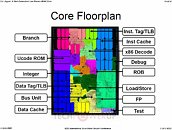- Joined
- Oct 9, 2007
- Messages
- 47,611 (7.45/day)
- Location
- Dublin, Ireland
| System Name | RBMK-1000 |
|---|---|
| Processor | AMD Ryzen 7 5700G |
| Motherboard | Gigabyte B550 AORUS Elite V2 |
| Cooling | DeepCool Gammax L240 V2 |
| Memory | 2x 16GB DDR4-3200 |
| Video Card(s) | Galax RTX 4070 Ti EX |
| Storage | Samsung 990 1TB |
| Display(s) | BenQ 1440p 60 Hz 27-inch |
| Case | Corsair Carbide 100R |
| Audio Device(s) | ASUS SupremeFX S1220A |
| Power Supply | Cooler Master MWE Gold 650W |
| Mouse | ASUS ROG Strix Impact |
| Keyboard | Gamdias Hermes E2 |
| Software | Windows 11 Pro |
AMD hedged its low-power CPU bets on the "Bobcat" micro-architecture for the past two years now. Intel's Atom line of low-power chips caught up in power-efficiency, CPU performance, to an extant iGPU performance, and recent models even feature out-of-order execution. AMD unveiled its next-generation "Jaguar" low-power CPU micro-architecture for APUs in the 5W - 25W TDP range, targeting everything from tablets to entry-level notebooks, and nettops.
At its presentation at the 60th ISSC 2013 conference, AMD detailed "Jaguar," revealing a few killer features that could restore the company's competitiveness in the low-power CPU segment. To begin with, APUs with CPU cores based on this micro-architecture will be built on TSMC's 28-nanometer HKMG process. Jaguar allows for up to four x86-64 cores. The four cores, unlike Bulldozer modules, are completely independent, and only share a 2 MB L2 cache.




"Jaguar" x86-64 cores feature a 40-bit wide physical address (Bobcat features 36-bit), 16-byte/cycle load/store bandwidth, which is double that of Bobcat, a 128-bit wide FPU data-path, which again is double that of Bobcat, and about 50 percent bigger scheduler queues. The instruction set is where AMD is looking to rattle Atom. Not only does Jaguar feature out-of-order execution, but also ISA instruction sets found on mainstream CPUs, such as AVX (advanced vector extensions), SIMD instruction sets such as SSSE3, SSE4.1, SSE4.2, and SSE4A, all of which are quite widely adopted by modern media applications. Also added is AES-NI, which accelerates AES data encryption. In the efficiency department, AMD claims to have improved its power-gating technology that completely cuts power to inactive cores, to conserve battery life.




View at TechPowerUp Main Site
At its presentation at the 60th ISSC 2013 conference, AMD detailed "Jaguar," revealing a few killer features that could restore the company's competitiveness in the low-power CPU segment. To begin with, APUs with CPU cores based on this micro-architecture will be built on TSMC's 28-nanometer HKMG process. Jaguar allows for up to four x86-64 cores. The four cores, unlike Bulldozer modules, are completely independent, and only share a 2 MB L2 cache.




"Jaguar" x86-64 cores feature a 40-bit wide physical address (Bobcat features 36-bit), 16-byte/cycle load/store bandwidth, which is double that of Bobcat, a 128-bit wide FPU data-path, which again is double that of Bobcat, and about 50 percent bigger scheduler queues. The instruction set is where AMD is looking to rattle Atom. Not only does Jaguar feature out-of-order execution, but also ISA instruction sets found on mainstream CPUs, such as AVX (advanced vector extensions), SIMD instruction sets such as SSSE3, SSE4.1, SSE4.2, and SSE4A, all of which are quite widely adopted by modern media applications. Also added is AES-NI, which accelerates AES data encryption. In the efficiency department, AMD claims to have improved its power-gating technology that completely cuts power to inactive cores, to conserve battery life.




View at TechPowerUp Main Site







